Charaka Indriya Sthana 1st Chapter Varnaswareeya Indriyam
1st chapter of Charaka Indriya sthana deals about signs and symptoms of imminent death as indicated by complexion and voice. The chapter name is Varnaswareeya Indriyam.
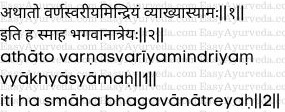
Now we shall expound the chapter on “Signs and Symptoms of Imminent Death as Indicated by complexion and Voice”. Thus said Lord Atreya[1-2]
Read – Acharya Charaka – Work, Samhita, Legacy, Chapters, Description
Table of Contents
Determination of residual span of life
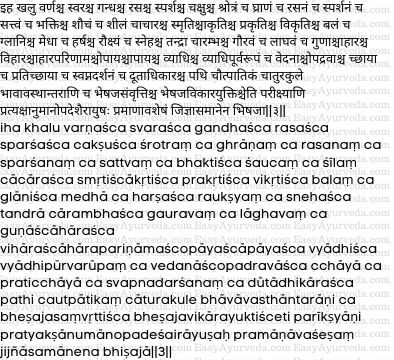
Below mentioned are the important factors which needs to be examined by the physician who wishes to know the residual life span of the patient by means of direct observation, inferential knowledge and scriptural testimony –
Complexion, voice, smell, taste, touch, eyes, ears, nose, tongue, skin, mind, desire, purity, conduct, achara – refined behavior, memory, shape, nature, vikrti – morbidity, strength, exhaustion, intelligence, harsha – exhilaration, dryness, unctuousness, drowsiness, onset of diseases, heaviness, lightness, qualities, diet, regimens, digestion of food, upaya – collection of diseases, apaya – disappearance of the disease suddenly, without any reason, premonitory features of the disease, pain, complications, lustre, shadow, dreams, bad omens seen by the physician, bad omens seen by the doctor on his way to the patient’s house, bad omens at the patient’s house, obstruction of medicines and defective medicines / absence of effects of medicine [3]
Read – Arishta Lakshanas – Ominous Signs And Symptoms Indicating Bad Prognosis
Method of examination
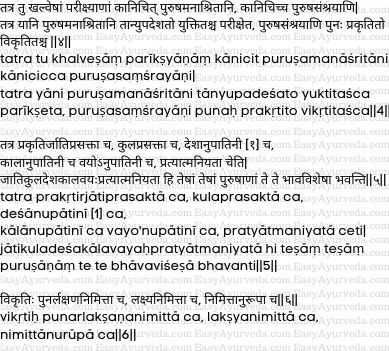
Among some of the factors described in the above verse some of them relate to the patients and some other factors do not relate to them. Scriptural inscriptions and inference are the two tools which help in ascertaining the factors which do not relate to the patients. The factors which are related to patients should be ascertained from their natural and unnatural (morbid) dispositions. [4]
Various types of Prakrti (natural disposition)
Depending on the distinct features of the below mentioned, the natural disposition is of six categories –
- Caste e.g. purity among Brahmanas
- Family e.g. purity with regard to character and conduct in a good family
- Geography e.g. manifested due to being born in a specific locality, country or geographical region e.g. people living in Banga / Vanga region are intellectual.
- Time factor e.g. purity in the Satya Yuga i.e the first epoch / good strength in visarga kala i.e. in the monsoon, autumn and early winter seasons and deficit strength in adana kala i.e. late winter, spring and summer
- Age factor e.g. predominance of kapha in childhood, predominance of pitta in the adolescence and adulthood and predominance of vata in old age
- Individuality / personal factor – depends on the physique, mind and sense organs of an individual and is different in different individuals [5]
Read – Bad Prognosis Based On Smell, Touch, Taste, Colour And Voice
Various types of Vikrti (unnatural disposition)
The morbid condition is of three types, viz
Lakshana nimitta – caused by bodily marks
Lakshya nimitta – caused by etiological factors and
Nimittanurupa – caused by such factors which resemble the etiological factors [6]
Bodily marks as indicative of unnatural disposition
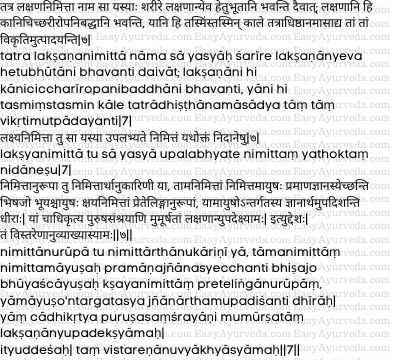
If the bodily marks indicate certain morbid conditions as a result of past actions they are called as Lakshana Nimitta. There are certain bodily marks / signs / symptoms which during the maturation of good or bad deeds get settled in some parts of the body and give rise to morbidities in due course of time. [7-i]
Read – Prognosis Signs Based On The Messenger – Doota Adhishtita Arishta
Etiological factors as indicative of unnatural disposition
If the morbid conditions are caused by etiological factors as described in Nidana section they will be known as Lakshya nimitta e.g. aggravation of Vata due to the intake of dry food etc etiological factors. Example – there are four causes / etiological factors of rajayakshma i.e. excessive indulgence in herculean activities, forcible withholding of natural urges, depletion of body tissues and eating foods in erratic / erroneous way. [7-ii]
Factors resembling etiological factors
These are the deformities / premonitory symptoms which serve the function (objective, purpose) of etiological factors i.e. producing a disease and giving the knowledge of the disease. Such unnatural situations i.e. symptoms are known as Nimittanurupa.
In real sense they are not causative factors. But they definitely serve as yardsticks in measuring the life span of individuals. Apart from this they are also indicators of death resulting from diminution of life span. Therefore the knowledge of these unnatural situations (symptoms) is of utmost importance. They help the physicians in ascertaining the life span of an individual which cannot be determined or confirmed by other tools of examination.
We shall describe such symptoms which are manifested in a person who is in very close proximity of death (death is almost ascertained). In this instance it is stated briefly but shall be explained in greater detail in the later contexts of the section. [7]
Normal and abnormal complexion
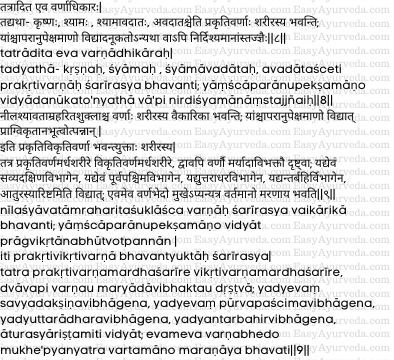
There are four types of natural complexions –black, bluish, bluish white and white
There are also some other types of natural complexions. They need to be ascertained by similarities (colors similar to the above mentioned) or from the instructions of experts.
Read – Bad Prognosis Of Diseases Based On Dreams and Shadows
Unnatural complexions
There are five types of unnatural complexions- blue, grey, coppery, green and albino (abnormally white)
Similarly, there are some other unnatural types of complexions which are produced anew. They too need to be understood on the basis of their similarity with the above mentioned abnormal complexions. Similarly if the natural complexion which was bestowed at birth changes in later part of one’s life, that complexion too shall be considered as abnormal.
Thus the normal (natural) and abnormal (unnatural) complexions in body are described. [8]
Combination of normal and abnormal complexions indicating imminent death:
It may so happen that half of the body may have natural complexion and the other half of the body would have unnatural complexion and both these complexions are demarcated by an even demarcating line. These normal and abnormal complexions simultaneously appearing in right and left sides, front and back sides, upper and lower parts or internal and external parts of the body should be considered as signs of imminent death for a given individual.
Natural and unnatural complexions may simultaneously appear in the face and other parts of the body; they also indicate imminent death of the individual. [9]
Read – How To Make Prognosis Of Disease According To Ayurveda?
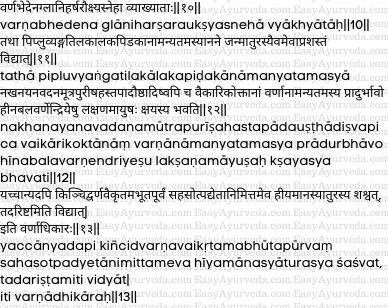
Similar other factors:
The description pertaining to the complexion also applies to other signs like emaciation and plumpness as well as dryness and unctuousness. [10]
Other morbid signs indicating imminent death
Similarly, the appearance of any one of the below mentioned on the face of the patient is indicative of imminent death – Piplu (port- wine mark), Vyanga (freckles), Tilakalaka (black mole) and Pidaka (Pimple) [11]
Morbid complexions
Appearance of any one of the abnormal colours in nails, eyes, urine, stool, hands, legs and lips (as described in Para 9 of this chapter) is indicative of imminent death if it is associated with diminution of strength, complexion and sensory perception [12]
Other morbid conditions
Sudden and accidental appearance of any other unusual morbid complexion is always indicative of growing weakness of the patient. They therefore appear in the form of premonitory signs of imminent death. [13]
Read – Bad Prognosis Based On Premonitory Symptoms Of Disease – Purvarupiya Arishta
Normal and abnormal voice
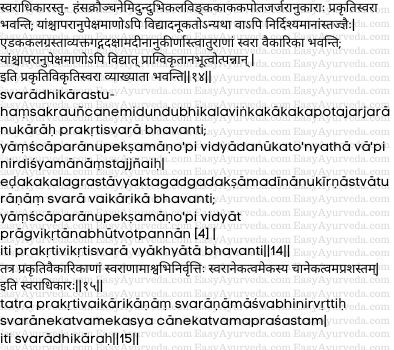
The normal human voice resembles the voice of one or more of the below mentioned Hamsa (swan), Kaauna (demoiselle crane), Nemi (wheel), Dundubi (Kettle drum), Kalavinka (house sparrow), Kaka (crow), Kapota (dove) and Jarjara (a type of drum)
There are some other types of natural voices which can be ascertained by similarities or from the instructions of experts. The voice of moribund patients resembles that of sheep (orwild Goat) and is feeble, inaudible, indistinct, chocked, hoarse and painful and unclear. Similarly, there are some other unnatural types of sounds which are produced anew. Thus the normal and abnormal types of voice of the individual are explained. [14]
Read – Role of Vata Dosha And Its Types In Speech And Voice
Morbidity in voice indication imminent death
The below mentioned types of voice related abnormalities too indicate imminent death –
– if the abnormal type of voice manifest spontaneously or
– in an individual there are many such abnormal types of voices or
– if only one abnormal voice in the individual appears to be of diverse types
Thus the morbidity pertaining to voice is explained. [15]

So the topics on complexion and voice are properly described with a view to provide knowledge regarding moribund persons. [16]
Recapitulation
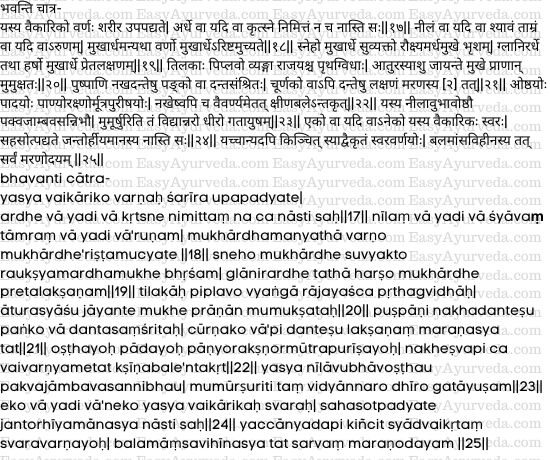
The following are the symptoms of moribund persons:
– Appearance of abnormal complexion in the entire or half of the body of the individual without any (visible) cause;
– If in half of the face there is blue, blackish, coppery or tawny colour and the colour of the reaming half is otherwise
– Manifestation of unctuousness in one half of the face and roughness in the other half
– Appearance of plumpness in one half of the face and emaciation in the other half
– Spontaneous appearance of various types of Tila (black Mole), Piplu (Port wine mark), Vyanga (freckles) and Raji (spots like Mustard) in the face of the patient
– Appearance of flower life spots in nails and teeth, and sticky and powder like substance in the teeth;
– Discoloration of lips, legs, heels, eyes, urine, stool and nails of the patient when he is diminished of strength
– When both the lips become bluish like the rip fruits of Jambu (Syzygium Cumini Skeels) and
– Sudden manifestation of single or multiple morbidities in the voice in a weak patient.
Such other abnormalities in the voice and complexion of an individual who is devoid of strength and flesh also indicate imminent death. [17-25]
Read – Ayurvedic Treatment For Freckles And Melasma
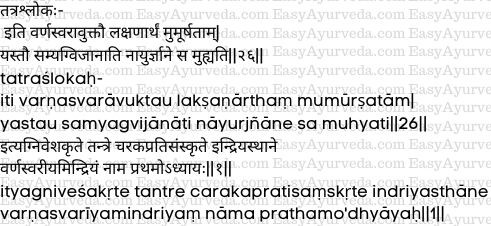
Various types of morbidity pertaining to complexion and voice are described here with a view to ascertaining in the signs and symptoms of moribund patients one who knows this does not tumble in ascertain the span of life. [26]
Thus ends the first chapter on signs and symptoms of Imminent Death as indicated by complexion and voice of Indriya section of Agnivesha’s work as redacted by Charaka.










